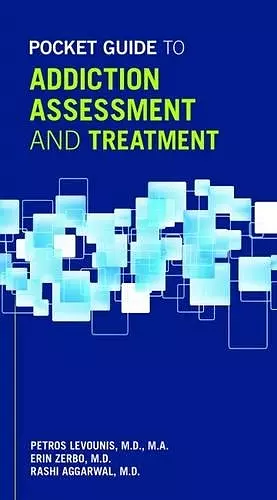Pocket Guide to Addiction Assessment and Treatment
Rashi Aggarwal editor Petros Levounis editor Erin Zerbo editor
Format:Paperback
Publisher:American Psychiatric Association Publishing
Published:2nd Jul '16
Currently unavailable, and unfortunately no date known when it will be back

Written in an engaging, straightforward style, the "Pocket Guide to Addiction Assessment and Treatment" provides easily accessed yet comprehensive information on all clinically important aspects of addiction. Whether at the bedside or in the office, any health care practitioner will find in this guide a quick, pertinent path to crafting an immediate treatment plan for their patients with substance use disorders or behavioral addictions. Andrew J. Saxon, M.D., Professor, Department of Psychiatry & Behavioral Sciences, Director, Addiction Psychiatry Residency Program, University of Washington, Director, Center of Excellence in Substance Abuse Treatment and Education (CESATE), VA Puget Sound Health Care System In summary, the Pocket Guide to Addiction Assessment and Treatment is an excellent guide for the medical student, resident, practitioner, and others involved in the addiction treatment field. Although it is not meant to be a textbook, it also serves as an excellent review for someone wishing to refresh themselves with a particular topic regarding substances, fundamentals of addiction, and treatment. Lon R. Hays, M.D., M.B.A.
Twenty concise chapters accessibly address a broad spectrum of topics, including the fundamentals of addiction; specific substances and addictive behaviors, including gambling disorder; and treatment approaches, including special issues with psychiatric and medical comorbidities.
Ambivalence, poor adherence to treatment, serious psychiatric and medical comorbidities—the difficulties posed by patients of substance use disorders are among the most challenging for practitioners to face. Given that only 10% of patients with these disorders actually receive specialized addiction treatment, it's clear that physicians in all medical and surgical specialties need to become comfortable assessing and treating substance use disorders.
The Pocket Guide to Addiction Assessment and Treatment is designed specifically to aid a wide range of clinicians, regardless of their training in addiction, to more confidently assess and treat this patient population.
The book's practical, actionable content is divided into three sections—Fundamentals of Addiction, Substances and Behaviors, and Treatment—that address topics including:
• The neurobiology of addiction
• How to recognize and treat intoxication, withdrawal from, and addiction to substances such as alcohol, anabolic-androgenic steroids, benzodiazepines, cannabis, opioids, stimulants, and tobacco, as well as hallucinogens, inhalants, and caffeine
• Special issues with psychiatric and medical comorbidities, as well as with specific populations
• Behavioral addictions, with a special focus on gambling disorder
• Cognitive-behavioral therapy; 12-step programs; nutrition and exercise; spirituality, mindfulness, and meditation; and other treatment options, with examples of how each can be used with patients facing addictions
With an accessible, easily referenced format, the Pocket Guide to Addiction Assessment and Treatment serves as a go-to resource for general psychiatrists, internists, family practitioners, pediatricians, emergency medicine physicians, psychiatric nurses, residents, medical students, and other practitioners involved in the addiction treatment field. And because all of the diagnostic discussions are DSM-5–based, readers can be confident that they're getting the most relevant and up-to-date guidance on the topic.
The editors of this book have in my view achieved most of their stated purpose. They have produced a concise yet broad ranging treatment of the topic of addiction, but it does require readers to have at least a degree of assumed knowledge. In that regard, one could speculate that part of their stated target group, medical students and allied health readers, might find the density of the writing off-putting.
This is a 335-page book which can physically fit in to a back pocket, but other than the introductory chapters, will lend itself more to use as a reference for specific topics, and reside on a bookshelf. An Australian readership is unlikely to find the statistics regarding US drug use patterns and prevalence of assistance.
Having aired those reservations about the complete achievement of the editors' ambitions, I would still recommend this book as a reference, a very useful addition to the medical library of Australian health practitioners. Its strengths outweigh its limitations. I would suggest that for medically trained readers its value would be obvious in emergency departments, detoxification centres, general practice and to general practice registrars.
-- Ken Hazelton, Orange, Australia * Drug and Alcohol Review *This pocket book is one of many such clinical quick reference guides. It is fairly comprehensive and well organized, making accessing information easy. It is well suited to the lab coat pocket of medical students, residents, fellows, and other healthcare providers with limited knowledge or experience treating this patient population.
-- Michael Easton, M.D. * Doody's Book ReviISBN: 9781585625123
Dimensions: 206mm x 114mm x 13mm
Weight: 313g
380 pages